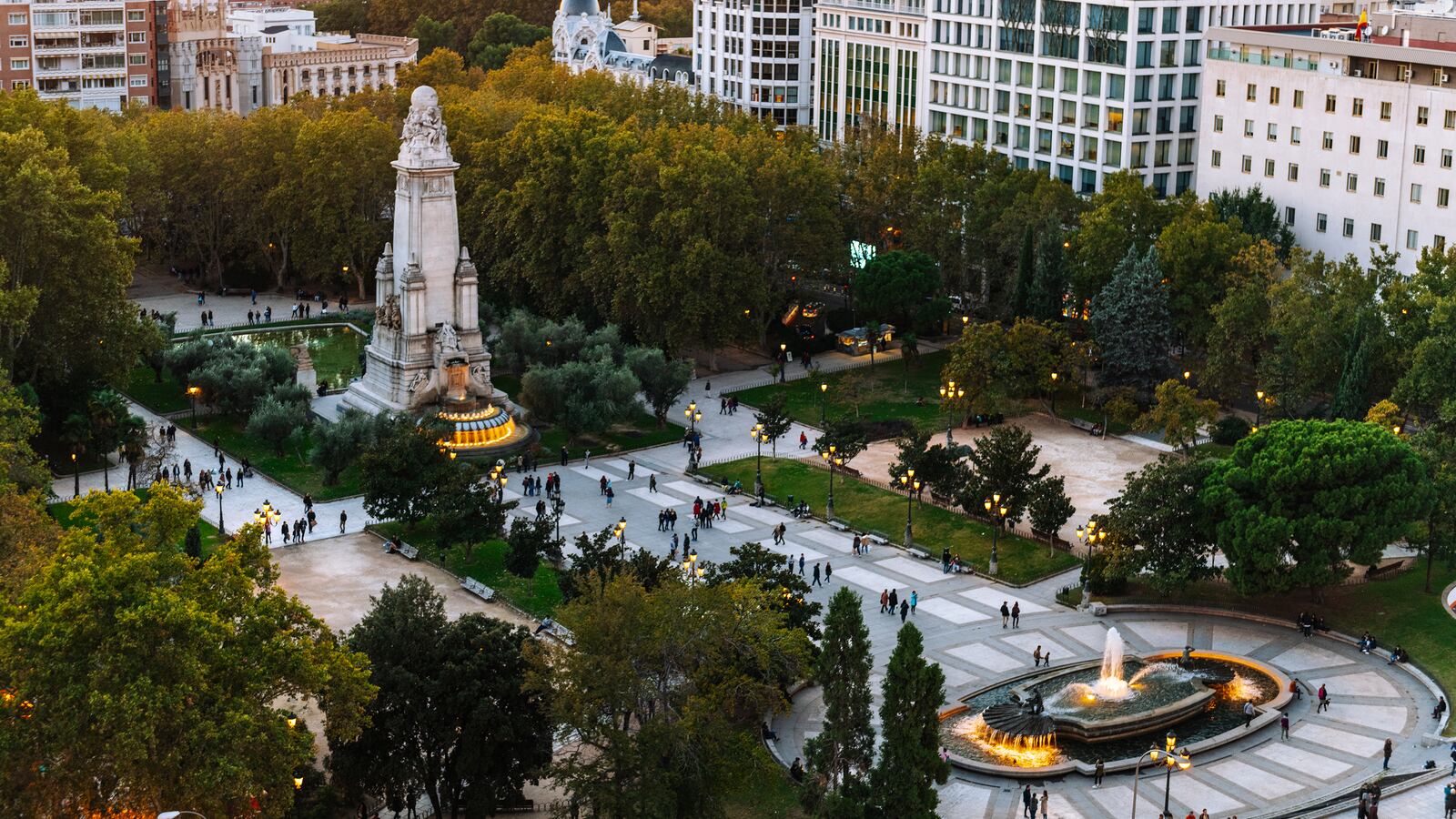Madrid is a city of plazas. Plazas for protesting and plazas for devouring potato tortilla. Plazas at the heart of blue-collar barrios and regal, frescoed plazas that inspire deference and awe. But until recently, Plaza de España—the city’s largest square, situated between the Royal Palace and the Gran Vía thoroughfare—was known for all the wrong reasons: illegal encampments, muggings after dark, exhaust-choked air, and the inexpungible odor of human excreta.
So in 2017, when progressive mayor Manuela Carmena greenlit a total renovation of the plaza based on the results of a public poll, most Madrileños were delighted: The renderings showed playgrounds, bike lanes, and leafy footpaths, plus walkways to nearby parks and monuments. This would be a plaza for the pueblo, one that put people over businesses and pedestrians over cars. “We’re going to improve the environmental quality of this area,” pledged José Manuel Calvo, Madrid’s then-delegate of Sustainable Urban Development, explaining that the square would be “more accessible and sustainable.”
Four years and $85 million later, Plaza de España’s makeover is essentially complete. Gone is the real-world Frogger simulation that hampered movement in and out of the square: You can finally stroll unencumbered between the Royal Palace and Plaza de España, a feat of urban planning that’s decades overdue. From there, take a peek at the freshly unearthed remains of a wing of Godoy Palace and San Gil Barracks before crossing zero lanes of traffic into the Parque del Oeste, a 240-acre oasis with rose gardens and a reconstructed Egyptian temple. Parque del Oeste unfurls southward to Madrid Río, a riverside park with 7 miles of esplanade, which, in turn, bleeds over into Casa de Campo, the city’s green lung that’s six times the size of Central Park. Translation? Madrid has a new, seamlessly interconnected green corridor with Plaza de España as its keystone. So far, so good.
But zoom in on the plaza itself, and things are less cut and dry. Photos from the inauguration on Nov. 22 revealed a barren, charmless expanse with sparse, leafless trees and flower beds filled with seemingly nothing but dirt. Many Madrileños, already cranky from years of closures and delays, were aghast. “They should call [it] Frying Pan Plaza. For its shape and because in the summer we’ll be fried alive if we go through it,” read one tweet, referring to the wide expanse of pavement in the center of the square. Another user posted a photo of an empty parking lot captioned “Plaza de España came out so pretty.” Had the citizenry been catfished? The disappointment was palpable—many lamented that the old plaza, for all its flaws, was dotted with shady patches and had a pretty neoclassical fountain that tempered the summer heat. It had ostensibly been bulldozed.
More vitriol was directed at Café de Cervantes, a new, contemporary triangular building with a metallic green exterior that one person likened to a moldy half-sandwich; other colorful comparisons included a hobbit’s house, a Teletubbies tribute, and a reinforced-concrete bunker. Undergirding the satire was a worry that the cold, space-age structure—and perhaps the plaza itself—was out of step with its stately surroundings.
Aesthetic quibbles aside, the most crucial question of all was whether the plaza was environmentally sound. Local reporting confirmed that all of the original granite would be reused and all of the excavated soil recycled, but a key goal in the renovation was to make the space green—one that was not fully met, according to geographer and city planner Antonio Giraldo Capellán. “Before, it felt like you were on an island surrounded by honking cars. The renovation improved things, but the architects simply hid the traffic underground,” he said in a phone interview. “They could’ve used this opportunity to address the root problem, which is the volume of traffic, by putting stronger regulations in place. They chose not to.”
Giraldo, who cuts through Plaza de España daily on his way to the office, has been keeping a close eye on the works since their inception. He said that despite the project’s environmental shortcomings, there’s far more to love than hate: A new bike lane ribbons around the perimeter; sleek wooden streetlights illuminate dark corners; and there’s a playground inspired by Cervantes’ imaginary Ínsula de Barataria with a staggering variety of slides, swings, and monkey bars.
Giraldo went as far as to defend the much-maligned “frying pan”: “It’s a highlight. We’re talking about a well-defined central venue that will be great for public concerts and activities,” he said, noting that people seeking green space can find it not only in other sections of the square but also in the surrounding parks.
In fact, according to both Giraldo and Enrique Sanz Crespo, the press secretary for Madrid’s department of public works, anyone claiming there are fewer trees in the new plaza is misguided. “One cannot say there’s a lack of vegetation when 1,100 trees have been planted,” Sanz wrote in an email. He chalked up those complaints to the winter season: Of course there’s no lush foliage or colorful flowers—yet.
Madrileños grieving the loss of the old fountain can also breathe easy knowing that it was merely being restored. It’s since been relocated some 200 yards from its original spot. And the moldy sandwich? Though the building pales in comparison to the eye-popping representation shown in the rendering, its cold, hulking proportions will soon soften as its outer walls sprout into a living wall of plants, grasses, and flowers.
Brushing off criticism as sensationalist and premature, city officials are celebrating the new square. At the inauguration, Madrid’s current mayor, José Luis Martínez-Almeida, called Plaza de España a 21st-century marvel. “It belongs to all of us” and “must fill us with pride,” he declared beside the bare saplings, adding that “the greatest reward will be the gratitude of all Madrileños.” Time will tell, but in the meantime, spring can’t come soon enough.

